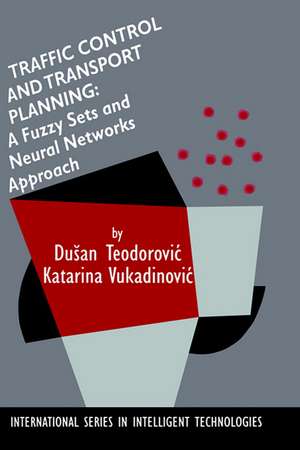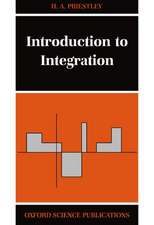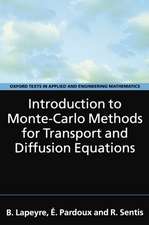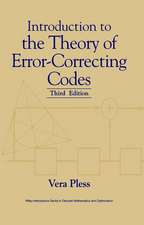Traffic Control and Transport Planning:: A Fuzzy Sets and Neural Networks Approach: International Series in Intelligent Technologies, cartea 13
Autor Dusan Teodorovic, Katarina Vukadinovicen Limba Engleză Hardback – 30 noi 1998
| Toate formatele și edițiile | Preț | Express |
|---|---|---|
| Paperback (1) | 1222.01 lei 6-8 săpt. | |
| SPRINGER NETHERLANDS – 21 oct 2012 | 1222.01 lei 6-8 săpt. | |
| Hardback (1) | 1228.47 lei 6-8 săpt. | |
| SPRINGER NETHERLANDS – 30 noi 1998 | 1228.47 lei 6-8 săpt. |
Din seria International Series in Intelligent Technologies
- 18%
 Preț: 959.36 lei
Preț: 959.36 lei - 18%
 Preț: 951.47 lei
Preț: 951.47 lei - 20%
 Preț: 1283.16 lei
Preț: 1283.16 lei - 18%
 Preț: 1224.99 lei
Preț: 1224.99 lei - 15%
 Preț: 643.99 lei
Preț: 643.99 lei - 18%
 Preț: 1225.94 lei
Preț: 1225.94 lei - 20%
 Preț: 1283.31 lei
Preț: 1283.31 lei - 15%
 Preț: 647.59 lei
Preț: 647.59 lei - 18%
 Preț: 960.42 lei
Preț: 960.42 lei -
 Preț: 381.21 lei
Preț: 381.21 lei - 18%
 Preț: 963.47 lei
Preț: 963.47 lei - 18%
 Preț: 958.73 lei
Preț: 958.73 lei - 18%
 Preț: 953.03 lei
Preț: 953.03 lei - 15%
 Preț: 643.99 lei
Preț: 643.99 lei - 15%
 Preț: 641.03 lei
Preț: 641.03 lei - 18%
 Preț: 1228.77 lei
Preț: 1228.77 lei - 15%
 Preț: 649.54 lei
Preț: 649.54 lei - 15%
 Preț: 647.08 lei
Preț: 647.08 lei
Preț: 1228.47 lei
Preț vechi: 1498.13 lei
-18% Nou
Puncte Express: 1843
Preț estimativ în valută:
235.06€ • 245.45$ • 194.11£
235.06€ • 245.45$ • 194.11£
Carte tipărită la comandă
Livrare economică 15-29 aprilie
Preluare comenzi: 021 569.72.76
Specificații
ISBN-13: 9780792383802
ISBN-10: 079238380X
Pagini: 387
Ilustrații: XVIII, 387 p.
Dimensiuni: 155 x 235 x 24 mm
Greutate: 0.75 kg
Ediția:1998
Editura: SPRINGER NETHERLANDS
Colecția Springer
Seria International Series in Intelligent Technologies
Locul publicării:Dordrecht, Netherlands
ISBN-10: 079238380X
Pagini: 387
Ilustrații: XVIII, 387 p.
Dimensiuni: 155 x 235 x 24 mm
Greutate: 0.75 kg
Ediția:1998
Editura: SPRINGER NETHERLANDS
Colecția Springer
Seria International Series in Intelligent Technologies
Locul publicării:Dordrecht, Netherlands
Public țintă
ResearchCuprins
1. Basic Definitions of The Fuzzy Sets Theory.- 1.1. The Concept of Fuzzy Sets.- 1.2. The Equality of Fuzzy Sets.- 1.3. Subsets of Fuzzy Sets.- 1.4. The Intersection of Fuzzy Sets.- 1.5. The Union of Fuzzy Sets.- 1.6. Fuzzy Set Height.- 1.7. Support of Fuzzy Set.- 1.8. The Scalar Cardinality of Fuzzy Set.- 1.9. Complement of Fuzzy Sets.- 1.10. Convex Fuzzy Sets.- 1.11. Linguistic Hedges.- 1.12. Fuzzy Sets as Points in Hypercubes.- 1.13. Fuzzy Relations.- 1.14. Max-min Composition.- 1.15. Extension Principle.- 1.16. Alpha Cut.- 1.17. The Concept ot a Fuzzy Number.- 1.18. Adding Fuzzy Numbers.- 1.19. Subtracting Fuzzy Numbers.- 1.20. Multiplying and Dividing Fuzzy Numbers.- 1.21. Multiplying a Fuzzy Number by a Constant.- 1.22. Triangular and Trapezoidal Fuzzy Numbers.- 1.23. Kaufmann and Gupta’s Method for Comparing Fuzzy Numbers.- 1.24. The Basic Elements of Fuzzy Systems 56 1.24.1. Graphical interpretation of fuzzy logic inference.- 2. Presentation of Fuzzy Models Developed in Transportation Applications.- 2.1. Vehicle Routing Model Based on the Rules of Fuzzy Arithmetic.- 2.2. Scheduling Algorithm for a Static Dial-a-ride Problem Based on Fuzzy Arithmetic Rules.- 2.3. Fuzzy Multiple-attribute Decision Making: The Choice of the Best Alternative for Organizing Air Shuttle Service.- 2.4. Controlling an Isolated Signalized Intersection Using Fuzzy Logic.- 2.5. A Fuzzy Traffic Control System on an Urban Expressway.- 2.6. Solving the Route-choice Problems in Urban Networks Using Fuzzy Logic.- 2.7. Modeling Route Choice with Advanced Traveler Information by Fuzzy Logic.- 2.8. Approximate Reasoning Route-choice Model on an Airline Network.- 2.9. A Fuzzy Logic Approach to the Vehicle Routing Problem when Demand at Nodes Is Uncertain.- 2.10. Air Traffic Flow Management ModelBased on Fuzzy Logic.- 2.11. Controlling a Fleet in River Traffic Using Fuzzy Logic.- 2.12. A Fuzzy Logic Approach to the Aircrew Rostering Problem.- 2.13. A Fuzzy Logic Approach to the Vehicle Assignment Problem.- 3. A Fuzzy Mathematical Programming Approach to Transportation.- 3.1. The Basic Premises of Fuzzy Mathematical Programming.- 3.2. Fuzzy Linear Programming.- 3.3. Solving a Fuzzy Linear Programming Problem when Constraint Coefficients Are Fuzzy.- 3.4. Solving a Fuzzy Linear Programming Problem when Objective Function Coefficients Are Fuzzy.- 3.5. Solving a Fuzzy Linear Programming Problem when the Constraints Are Fuzzy.- 3.6. Airline Network Design by Fuzzy Linear Programming.- 3.7. Airline Network Seat Inventory Control: a Fuzzy Mathematical Programming Approach.- 4. Applications of Artificial Neural Networks in Transportation.- 4.1. Basic Concepts of Artificial Neural Networks.- 4.2. Transportation Demand Forecasting with Neural Network Models.- 4.3. Backpropagation Neural Network for Estimation of an Origin-destination Matrix.- 4.4. Backpropagation Neural Network for Estimating a Real-time Origin-destination Matrix from Traffic Counts.- 4.5. Neural Network Approach to Transportation Network Improvement Problem.- 4.6. Routing and Scheduling Algorithm for the Dynamic Dial-a-ride Problem Based on Neural Networks.- 4.7. A Neural Network Approach to Mitigation of Vehicle Schedule Disturbances.- 4.8. A Neural Network Approach to Vessel Dispatching Problem.- 5. Generating and Tuning The Fuzzy Logic Systems Developed in Transportation Applications.- 5.1. Membership Functions Design.- 5.2. Membership Value Assignment Process Based on Intuition.- 5.3. Membership Value Assignment Process Based on Facts and Knowledge.- 5.4. Membership Value Assignments as a Combinatorial Optimization Problem.- 5.5. Method To Generate Fuzzy Rules from Numerical and Linguistic Information.- 5.6. Simultaneous Design of Membership Functions and Fuzzy Rules from Numerical Information by Genetic Algorithms.- 5.7. An Application of Neurofuzzy Modeling: The Vehicle Assignment Problem.- References.
















